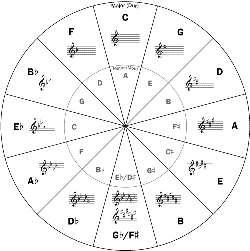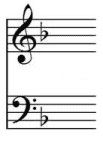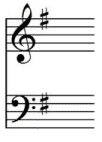Key Signatures and the Circle of Fifths
Like time signatures, key signatures tell you important information about a piece of music. The key signature tells the musician what key the music is played in. This means what pitch range the entire song will take place in and it also tells the musician what notes sound good and what notes sound not so good, especially when improvising.
Musical Keys are made up of certain notes that sound good together. There are a total of 12 different keys that a song can be in, each one has different notes, though some of the notes overlap with different keys.
Common Key Signatures
By far the most common key signature is the key of 'C'. This is because the key of C doesn't have any sharps or flats (sharps or flats mean a note is changed, such as F sharp or B flat). Since the key of C doesn't have any sharps or flats, there is nothing to write on the key signature.
Another common key is the key of F. The key of F has one flat, B flat. This means that you can play any natural (white key) note except for B, which you need to play as B flat instead and you will remain in the key of F. We would write the key of F as shown below, with a flat symbol (looks like a lower case 'b') over the B line on the staff.
Another key that is very common is the key of G, in which there is only one sharp, F sharp. Again, this means that you can play any natural note except for F, which you need to play as F sharp. We would write this key signature as a symbol (#) on the F line of the staff. You can see below how this will look on the staff.
The Circle of Fifths
The circle of fifths is a symbol diagram which shows you the standard progression of keys if you were to move on intervals of fifths. When I say fifths, I am speaking of the note in a scale. Take for example the key of C, if we play a C scale (CDEFGABC) then the fifth note in that scale is the G, therefore the G is a fifth above the C.
With that in the back of your mind, be aware that going from G up to C is a forth and not a fifth. This is because the notes in the G scale are G-A-B-C-D-E-F# (the # symbol means sharp)-G so C represents the fourth note in the G scale. So thinking about this, if the circle of fifths goes by fifths in one direction, it would go by fourths in the opposite direction; this is an important fact to note.
The circle starts with C at the very top, and like I just mentioned, if we head clockwise on the circle, we are increasing by fifths and if we head counter clockwise on the circle, we are increasing by fourths.

As you can see in the diagram, if we head in the fifths direction (towards the sharp keys), we will go from the key of C, to the key of G, to the key of D, to the key of A, to the key of E, to the key of B, to the key of F# and finally to the key of C#.
If we head towards the fourths, or the flat keys, we go from the key of C to the key of F, to the key of Bb (remember the lowercase b is the symbol for a flat), to the key of Eb, to the key of Ab, to the key of Db (which is also the same key as C#, just written another way), to the key of Gb (or F#) and finally to the key of Cb (which is more commonly known as the key of B).
Relative Minor Keys
Another nice feature of the circle of fifths is the relative minor keys. These are created by taking the major key, and playing the same notes in the scale, but starting on the 6th note in the scale and playing up to the next sixth note in the scale. For example, take the key of C. If you play a C scale, but go from A up to A instead, that is the relative minor.
Order of Sharps and Flats When Written
You may have noticed, but the order of sharps and flats as they are written on the staff are kind of odd. When writing the key signature that has sharps in it, you will always write them (from left to right) in this order: F#, C#, G#, D#, A#, E# and B#. This is because this corresponds with the circle of fifths and the order that keys are place around the circle.
The same applies when writing the flats, except the order is (naturally) reversed: Bb, Eb, Ab, Db, Gb, Cb and Fb.
A good phrase for the acronym BEADGCF is “BEAD, Green Cows Fly.” Or you could use something more common like “Battle Ends and Down Goes Charles' Father” or this one I just recently read “Bald Eagles are Daring Grand Canyon Flyers.” Whatever you come up with, just remember that that is the order of the flats. The order of the sharps is the reverse of that FCGDAEB which could stand for “Fudge Can Get Delicious and Entertain Boys” or anything you can think of to remember that order.

